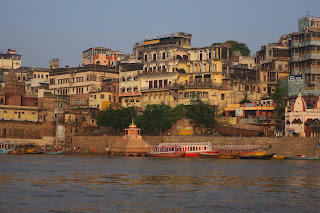Ghats in Varanasi are riverfront steps leading to the banks of the Ganges
river. The city has 84 ghats. Most of the ghats are bathing and puja
ceremonial ghats, while two ghats, Manikarnika and Harishchandra, are used
exclusively as cremation sites.
Most of the ghats in Varanasi were rebuilt in the 18th century under the
maratha patronage.
Many ghats are associated with legends or mythologies while other ghats have
private histories and users. A morning boat ride on the Ganges along the ghats
is a popular visitor attraction.
|
Sadhus gather near Dashashwamedh Ghat.
Sadhus are religious ascetics, mendicants or any holy person in
Hinduism, Buddhism and Jainism who has renounced worldly life.
-
Sadhu means one who practises a 'sadhana' or keenly follows a path of
spiritual discipline.
-
A sadhu's life is solely dedicated to achieving liberation from the
cycle of death and rebirth (moksa), the fourth and final stage of life
(asrama), through meditation and contemplation of Brahman.
-
Sadhus often wear simple clothing, such as saffron-coloured clothing
in Hinduism and white or nothing in Jainism, symbolising their
renunciation of worldly possessions (sannyasa).
-
See more at
Sadhu - Wikipedia.
|
|
Approaching Dashashwamedh Ghat.
|
|
Heading downstairs towards Varanasi Boat Ride.
|
|
Sadhu sitting in the middle of the stairs.
|
|
Varanasi Boat Ride.
No trip to Varanasi is complete without a sunrise or sunset boat ride of
the Ganges.
|
|
Dashashwamedh Ghat from north to south.
The two large cylinders seen on the right side of the photo are the Ghat
Sewage Pumping Station (1970-1971).
-
The Ganges suffers from extreme pollution levels, caused by the 400
million people who live close to the river.
-
Sewage from many cities along the river's course, industrial waste and
religious offerings wrapped in non-degradable plastics add large
amounts of pollutants to the river as it flows through densely
populated areas.
-
See more at
Pollution of the Ganges - Wikipedia.
|
|
Sun begins to rise.
The sun begins to rise on the other bank of the Ganges River.
|
|
Dashashwamedh Ghat.
Dashashwamedh Ghat is a main ghat in Varanasi located on the Ganges
River in Uttar Pradesh. It is located close to Vishwanath Temple.
-
There are two Hindu legends associated with the ghat: according to
one, Brahma created it to welcome Shiva, and in another, Brahma
sacrificed ten horses during Dasa-Ashwamedha yajna.
-
See more at
Dashashwamedh Ghat - Wikipedia.
|
South of Dashashwamedh Ghat
|
The sun rises a little more.
|
|
Ahilyabai Ghat.
Ahilyabai Ghat has the distinction of being the first ghat named in
honor of a person, namely, the warrior queen Ahilyabhai Holkar of Indore
who actually built it in 1778 along with a number of temples and
spiritual residences throughout the city of Varanasi.
|
|
The sun rises a little higher.
|
|
Kedar Ghat.
At the top of the stairs you can see the Gauri Kedareshwar Temple.
|
|
Harishchandra Ghat.
In the Hindu tradition, cremation is one of the rites of passage, and
the Ghats of Varanasi are considered one of the auspicious locations for
this ritual.
-
At the time of the cremation or "last rites", a prayer (puja) is
performed by one or more Hindu priests. Sacred hymns and mantras are
recited during cremation to mark the ritual.
-
The Manikarnika and Harishchandra Ghats are dedicated to the cremation
ritual.
-
Annually, less than 2 in 1000 people who die in India, or 25,000 to
30,000 bodies are cremated on various Varanasi Ghats; about an average
of 80 per day.
-
See more at
Ghats in Varanasi, Cremation on ghats - Wikipedia.
|
|
Dandi Ghat.
Dandi Ghat is one of the prominent ghats of Varanasi and mostly visited
by the faithful to take a holy dip in the Ganges and have blessings of
the ascetics in a monastery located at the top of the flight of the
stone steps.
-
The Dandi Ghat was built by local Varanasi businessman Lallu Ji
Agarwal in the 19th century in honor and comfort to the staff-carrying
Dandi monks, a symbol of spiritual (non-religious) righteousness and
‘Dharma’ rule.
-
These Dandi Swamis or monks were the torchbearers of Dharma – the
fundamental principles that govern the universe.
-
As the place above the ghat was a monastery of staff-bearing ascetics,
this ghat was on the banks of the river Ganga and was called Dandi
Ghat.
|
North of Dashashwamedh Ghat
|
Dharahara Mosque (Masjid Dharara).
Mughal-style, 17th-century mosque with 3 huge domes and steps nearby for
ritual bathing in the Ganges.
- Dharahara Mosque is located in Panchganga Ghat.
|
|
Vishnu Ji Charan Paduka Temple.
Vishnu Ji Charan Paduka Temple is located near Scindia Ghat.
|
|
Ratneshwar Mahadev Temple (bottom right corner).
Ratneshwar Mahadev Mandir (also known as Leaning temple of Varanasi) is
one of the most photographed temples at Manikarnika Ghat.
-
The temple, while apparently well-preserved, leans significantly
towards the back side (north-west), and its garbhagriha is generally
below the water much of the year, except for a few months during the
summer.
- The temple has developed a nine-degree slant.
-
See more at
Ratneshwar Mahadev temple - Wikipedia.
|
|
Manikarnika Ghat.
The boat trip started from Dashashwamedh Ghat and ended at Manikarnika
Ghat.
-
Manikarnika Ghat is one of the holiest cremation grounds among the
sacred riverfronts (ghats), located on the Ganges.
-
In Hinduism, death is considered a gateway to another life marked by
the result of one's karma.
-
It is believed that a human's soul attains moksha, and hence
breaks the cycle of rebirth when cremated here.
-
The ghat is named after Sati's earrings which fell here. The Hindu
genealogy registers at Varanasi are kept here.
-
See more at
Manikarnika Ghat - Wikipedia.
|
See also
Source
Location
Ganga Aarti Ritual
Manikarnika Ghat
Gyanvapi Mosque
Vishwanath Temple
Bharat Mata Temple
Durga Temple in Varanasi
Shakti Religion

































